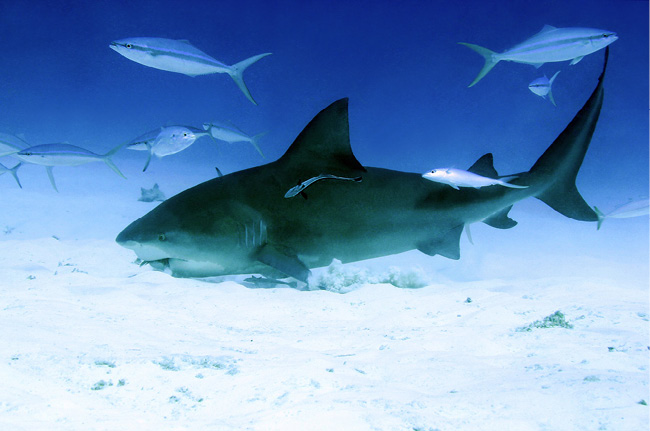Title Page
101 AMAZING FACTS ABOUT SHARKS
Jack Goldstein
Publisher Information
Published in 2014 by
Andrews UK Limited
www.andrewsuk.com
The right of Jack Goldstein to be identified as the author of this work has been asserted by him in accordance with the Copyright, Designs and Patents Act 1998
Copyright 2014 Jack Goldstein
All rights reserved. No part of this publication may be reproduced, stored in a retrieval system, or transmitted, in any form or by any means without the prior written permission of the publisher, nor be otherwise circulated in any form of binding or cover other than that in which it is published and without a similar condition being imposed on the subsequent purchaser. Any person who does so may be liable to criminal prosecution and civil claims for damages.
All facts contained within this book have been researched from reputable sources. If any information is found to be false, please contact the publishers, who will be happy to make corrections for future editions.
Introduction
Did you know that most sharks have an excellent sense of hearing? Or that fear of sharks is known as galeophobia? This fantastic quick-read eBook features over one hundred facts split into categories such as shark attacks, conservation, myths, record breakers and many more. So if you want to know how long a whale shark can live for, or what the Aztecs used to ward off sharks, then this is the book for you! Find the information you want, fast.
Follow Jack Goldstein on Twitter @GoldsteinBooks
Visit Goldstein Books at www.jackgoldsteinbooks.com
The Basics
- Sharks are a type of fish which have certain characteristics which include pectoral fins which are not fused to the head, between five and seven gill slits and a skeleton made from cartilage.
- There are over five hundred species of sharks living in the planets oceans.
- Sharks are found in almost every sea on the planet.
- The method by which a shark swims can be compared to that of how an airplane flies; as it swishes its tail to move itself forwards (like a propeller does on a plane), water moves over its fins which creates a kind of lift, like a planes wings.
- Sharks can swim hundreds of miles in just a single day.
- Signs that a shark is about to attack its prey include a hunching of the back, a lowering of its pectoral fins and swimming in a zig-zag pattern.
- Sharks can dislocate their upper jaws to help them grab and hold onto their prey.
- Rather than scales, sharks have a special type of skin called denticles which allow them to move swiftly through the water without picking up barnacles and the like.
- The average shark lives to around the age of 25, however some can survive for over one hundred years.
- Many sharks are excellent hunters, stalking their prey from a distance until the perfect moment arises for them to strike.

A Great White Shark
General Facts
- Some great white sharks have been observed jumping up to three metres out of the water to catch nearby seals.
- Some sharks eat their siblings whilst they are still in their mothers womb - this isnt because they are naturally evil, it just happens to be the best source of nutrients as they are growing!
- Injured and dying fish often make a sound that is too low for humans to hear but that sharks have a keen perception for. Scientists have dubbed this noise the yummy hum!
- At the back of each of its eyes, a shark has a membrane called the tapetum lucidum which reflects as much light as possible back into the eye itself. This therefore means that the shark can see in murky water or low-light conditions much better than animals without this ability.
- More people are killed every year by falling coconuts than they are by sharks.
- A species called the gill frilled shark was discovered off the coast of Japan in 2007. This incredible creature is closer in evolutionary terms to the sharks of prehistoric times and has certainly made many marine biologists wonder what else may be swimming undiscovered in the worlds oceans.
- Sharks have many different senses to humans. For instance, they are able to sense pressure waves in the water through their lateral line organs which enable them to detect the location of a target, and even the direction in which it is swimming.
- Some species of shark have organs called photospheres which emit light; we believe this is either to act as a kind of camouflage or to attract a mate.
- The cookie cutter shark fools its prey into thinking it is a small snack! The shark has a small strip on its neck that is designed to look like a much smaller fish, which the unwary enemy may fancy as a light snack. As it approaches closer however, the cookie cutter quickly takes a bite out of its would-be attacker and swims away!
- The reason that hammerhead sharks have such an unusual shape is that they have electroreceptors along their particularly wide heads which allow them to pinpoint potential prey better and thus become even more efficient hunters.
Shark Attacks
- Only three per cent of the worlds shark species are known to attack humans.
- Shark attacks on humans are rare, however they do happen - there are around forty or fifty reports of this happening every year.
- Although many people are afraid of sharks, it is they who should be scared of us; humans kill around eighty million of them every year.
- Many people are scared of being attacked and killed by a shark, however the chances of this happening are much lower than being killed by dogs, bees or wasps.
- It is in fact even rarer that an attack is fatal; only between one tenth and one fifth of these result in death.
- Somewhat amusingly, the chances of being bitten by a shark is significantly lower than being bitten by another human being!
- The three most likely species of shark to attack humans are the great white, the tiger shark and the bull shark. The main reasons for this is that their prey is usually human sized, and they are top of the food chain so arent scared of anything - including us!
- If a shark does bite a human, it usually wont have a second try. Once it has figured out the flesh it has ripped off is not from a sea creature (as we taste very different to them) it will usually swim away.
- The majority of people when asked would say that the shark they were most afraid of would be the great white, however between 1580 and 2007 - a period of over four hundred years - there has only been a total of 64 fatal attacks by the species.
- The region that has seen the most shark attacks is Volusia County; there have been more than two hundred attacks here since the last years of the nineteenth century - although most of them were minor bites rather than fatalities.

A Bull Shark
Shark Biology
- A sharks liver contains a large amount of oil, which acts as a buoyancy aid and keeps it balanced in the water.
- Some (but not all) sharks need to keep moving otherwise they will drown. Species such as the great white and the mako do not have muscles which other species do that pump water through their mouths and over their gills; they need the flow of the water as they are swimming to do this.
- It is not the look of blood in the water that attracts a shark; it is in fact another sense altogether. Sharks have electroreceptors that can detect even the smallest change. As blood alters the waters conductivity, it is actually this that alerts a shark to the situation.
Next page














